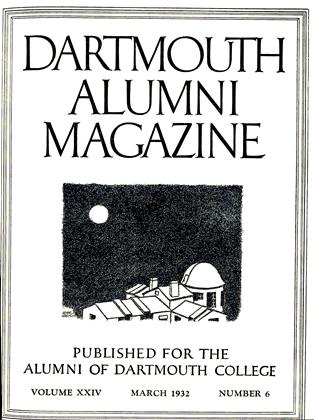IN the face of the utmost opposition from the weather man, those in charge of Dartmouth's twenty-second Winter Carnival would not be discouraged. Preparations continued without rest and in the end, with but little more than twenty-four hours to spare—King Winter broke through with a blanket of snow thick enough and white enough to give Dartmouth all that could be asked in the way of a Carnival setting.
Snow or no snow, Carnival was ready to begin. True, Campus and fraternity decorators turned from snow to ice as their medium and many would-be sculptors were forced to develop a new technique overnight, but as the hundreds of Carnival guests arrived for Hanover's winter celebration, there was little evidence of the last hectic rush. From his massive ice pedestal in the center of the campus, Eleazer Wheelock's giant statue beamed a welcome to all; the log shelter before Robinson Hall, with its snow and evergreen background was a new addition to the familiar Carnival effects; and the usual fraternity competition in snow sculpture found a new array of beauties, monsters, and "what shall-we-call-its" among which Theta Chi won first prize and Kappa Sigma second.
The social side of Carnival opened in all its glory Friday night with the spectacular Schneefest. As the long line of Carnival guests and their escorts reached the golf course, the most promising candidates for Queen of the Snows were selected by a Committee of Corey Ford, T. E. Geisel '25 (Dr. Seuss), and Dr. Joel B. Hayden, Headmaster of Western Reserve Academy.
The Schneefest setting was all that could be asked for. The glistening artificial rink immediately before the grand stand was illuminated by the soft glow of lights hidden in ice pillars surrounding the rink. The Queen's throne on the further side of the rink reflected the rays thrown on it by spotlights to stand out most attractively against its flanking pine trees. Further up on the hillside was the much talked of castle with varicolored flares twinkling from its windows and its glistening surface standing out even against the newly fallen snow. The story of "Winter Wins his Queen" has been given here before. True to form, midget gnomes with sinister shadows frolicked before the castle as they guarded it; half a hundred skiers attacked once, twice and a third time; and at last Winter was able to lead forth his Queen, Miss Betty Glendinning of Scarsdale. King, Queen, Court, and guard arranged themselves on and about the throne; figure skaters displayed their skill; fireworks illuminated the region; and as advertised in a mammoth blaze the castle was burned to the ground.
In the Winter Sports Competition Dartmouth came into its own, outdistancing New Hampshire by 27 points in a rout that helped to make up for past defeats. Scoring in every event, Dartmouth's team gave a wonderful exhibition of competitive fight.
In the absence of Jack Shea (at the Olympics), his usual runner-up, Don Mahoney stepped out to win both the 440-yard and the two-mile speed skating, while Dartmouth took all the places in the figure skating with no competitors. Such familiar figures as Dick Goldthwait, Tom Mann, and Bill Dewey accounted for points in the Slalom and downhill races in their consistent manner, but a new competitor broke into the open when R. L. Emerson '34 of Manchester, N. H., took second in the Slalom and first in the downhill to top Dartmouth's ski list. Nor did Dartmouth slacken speed on the second day of the meet. Mann won the crosscountry ski race, F. J. Lepreau '34 placed third in the snowshoe race, and J. E. Flint '32 jumped into second place in Saturday afternoon's competition at the big jump.
Carnival activities, from the Outing Club point of view, came to a most spectacular finish in the ski jumping on Saturday afternoon. For the first time the remodeled jump was given an official test and both spectators and jumpers were more than satisfied. The Collegiate Jumping was won by a Bowdoin skier, Dartmouth second, and Maine and St. Lawrence tied for third. It was in the Open Class, however, that the thrills came. Strand Mikkelsen, jumping for the Greenfield Outing Club, came within less than a foot of breaking Charlie Proctor's six-year-old record of ISO feet. Mikkelsen, National Jumping Cham- pion in 1929, runner-up in 1930, and third in 1931, was expected to furnish thrills and no one was disappointed. Proctor's record was made when the jump was very fast. Mikkelsen's when the heat of the sun made the jump a little slow. But jump enthusiasts saw enough for one day's thrills.
And so Carnival has once more come and gone—for another year!
The illustration above is a photograph ofthe ice statute of Eleazar Wheelock made forCarnival by M. 0. Waldsmith '33.
 View Full Issue
View Full Issue
More From This Issue
-
 Article
ArticleFrom War to Depression
March 1932 By Bruce Winton Knight -
 Lettter from the Editor
Lettter from the EditorEditorial Comment
March 1932 -
 Lettter from the Editor
Lettter from the EditorDartmouth Manuscript Series—The First Volume
March 1932 -
 Article
ArticleProfessor Einstein, Relativity, and Mt. Wilson
March 1932 By Walter S. Adams -
 Class Notes
Class NotesCLASS OF 1931
March 1932 By Jack r. Warwick -
 Class Notes
Class NotesCLASS OF 1905
March 1932 By Arthur E. McClary







